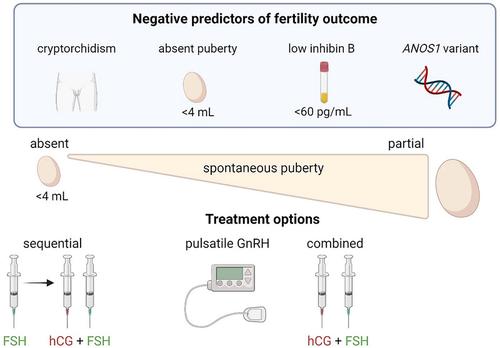当前位置:
X-MOL 学术
›
Ann. N. Y. Acad. Sci.
›
论文详情
Our official English website, www.x-mol.net, welcomes your
feedback! (Note: you will need to create a separate account there.)
Current landscape of fertility induction in males with congenital hypogonadotropic hypogonadism
Annals of the New York Academy of Sciences ( IF 4.1 ) Pub Date : 2024-08-27 , DOI: 10.1111/nyas.15214 Andrew A Dwyer 1, 2 , Isabella R McDonald 2 , Richard Quinton 3, 4
Annals of the New York Academy of Sciences ( IF 4.1 ) Pub Date : 2024-08-27 , DOI: 10.1111/nyas.15214 Andrew A Dwyer 1, 2 , Isabella R McDonald 2 , Richard Quinton 3, 4
Affiliation

|
Congenital hypogonadotropic hypogonadism (CHH) is a rare reproductive disorder caused by deficient secretion or action of gonadotropin-releasing hormone (GnRH) and is a hormonally treatable form of male infertility. Both pulsatile GnRH treatment and combined gonadotropin therapy effectively induce spermatogenesis in 75%–80% of males with CHH, albeit the ejaculate does not usually approach normal semen parameters by WHO criteria. This is in some contrast to the cumulative fertility outcomes in females with CHH on gonadotropin treatment that are indistinguishable from those of reproductively normal females. Emerging data provide insights into early life determinants of male fertility (i.e., minipuberty), and research has identified key predictors of outcomes for fertility-inducing treatment in men with CHH. Such developments provide mounting evidence for tailoring approaches to maximize fertility potential in CHH, although there is no clear consensus to date on the optimal approach to fertility-inducing treatment. This review provides an up-to-date review on the current evidence underpinning therapeutic approaches for inducing spermatogenesis in males with CHH. In the absence of evidence-based clinical guidelines, this synthesis of current evidence provides guidance for clinicians working with males with CHH seeking fertility.
中文翻译:

先天性低促性腺激素性性腺功能减退症男性诱导生育能力的现状
先天性低促性腺激素性腺功能减退症 (CHH) 是一种罕见的生殖疾病,由促性腺激素释放激素 (GnRH) 分泌或作用不足引起,是一种可通过激素治疗的男性不育症。搏动 GnRH 治疗和促性腺激素联合治疗均可有效诱导 75%-80% 的 CHH 男性患者发生精子,尽管根据 WHO 标准,射精通常不会接近正常的精液参数。这与接受促性腺激素治疗的 CHH 女性的累积生育结果形成鲜明对比,后者与生殖正常女性的累积生育结果没有区别。新出现的数据提供了对男性生育能力的早期生活决定因素(即短青春期)的见解,并且研究已经确定了 CHH 男性生育诱导治疗结果的关键预测因素。这些发展为定制方法以最大限度地提高 CHH 的生育潜力提供了越来越多的证据,尽管迄今为止尚未就诱导生育力治疗的最佳方法达成明确的共识。本综述对当前支持诱导 CHH 男性精子发生的治疗方法的证据进行了最新综述。在缺乏循证临床指南的情况下,这种对当前证据的综合为临床医生与寻求生育能力的男性 CHH 患者一起工作提供了指导。
更新日期:2024-08-27
中文翻译:

先天性低促性腺激素性性腺功能减退症男性诱导生育能力的现状
先天性低促性腺激素性腺功能减退症 (CHH) 是一种罕见的生殖疾病,由促性腺激素释放激素 (GnRH) 分泌或作用不足引起,是一种可通过激素治疗的男性不育症。搏动 GnRH 治疗和促性腺激素联合治疗均可有效诱导 75%-80% 的 CHH 男性患者发生精子,尽管根据 WHO 标准,射精通常不会接近正常的精液参数。这与接受促性腺激素治疗的 CHH 女性的累积生育结果形成鲜明对比,后者与生殖正常女性的累积生育结果没有区别。新出现的数据提供了对男性生育能力的早期生活决定因素(即短青春期)的见解,并且研究已经确定了 CHH 男性生育诱导治疗结果的关键预测因素。这些发展为定制方法以最大限度地提高 CHH 的生育潜力提供了越来越多的证据,尽管迄今为止尚未就诱导生育力治疗的最佳方法达成明确的共识。本综述对当前支持诱导 CHH 男性精子发生的治疗方法的证据进行了最新综述。在缺乏循证临床指南的情况下,这种对当前证据的综合为临床医生与寻求生育能力的男性 CHH 患者一起工作提供了指导。


















































 京公网安备 11010802027423号
京公网安备 11010802027423号